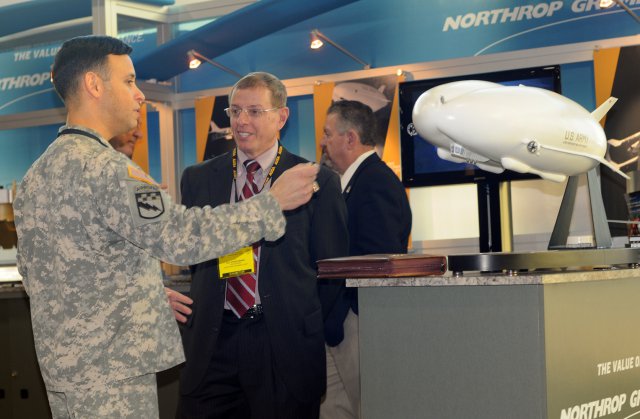
Lt. Col. Hilton Nunez, with Army G-2, talks with Steve Bond of Northrop Grumman about the Long Endurance Multi-Intelligence Vehicle, near a model of the LEMV, during the Association of the United States Army Aviation Symposium and Exposition - Photo: C. Todd Lopez
During the Association of the United States Army Aviation Symposium and Exposition, just outside Washington, D.C. on January 12th., Lieutenant General Robert P. Lennox, Deputy Chief of Staff, Army G-8, touched on the future of vertical take-off and landing unmanned aircraft systems.
The General said Army aviation has a “good path” for vertical UAS. “We are using overseas contingency operations dollars and we are hustling systems to theatre and we hope to learn from that.”
The Army expects to test the Long Endurance Multi-Intelligence Vehicle in Afghanistan this summer. It’s a hybrid air vehicle — like a blimp — that can carry multiple ISR payloads for more than 21 days at altitudes greater than 22,000 feet. The LEMV, developed by Northrop Grumman, “has got some real promise,” the general said. “We will see the value of the persistent stare that that gives us.”
Other VTOL capabilities the Army is looking at include the Boeing A160 Hummingbird. “It’s wonderful not being tied to a long runway,” Lennox said. And the platform’s long endurance and “pretty good stare capability when teamed with some of the latest sensors … I think it can give us some powerful capabilities.” Where such pieces of equipment can go in the Army, or if the Army can even afford them, remains to be seen, he said. “We think it’ll help in Afghan significantly.”
Lieutenant General William N. Phillips, with the Army Acquisition Corps and the Office of the Assistant Secretary of the Army for Acquisition, Logistics and Technology, said the Army must consider vertical UAS “through an affordability lens. What does this provide to the Army, what capability could it provide and then again how much does it cost?”
Phillips said the Army has experienced “exponential growth in UAS,” and the growth, he said, has been successful. “The ground brigade commanders, battalion commanders, company commanders — have learned how to use UAS in the most extraordinary ways, to extend their ability to achieve a situational awareness on the battlefield.”
Source: www.Army.Mil

The tiltplane is a VTOL concept which offers an efficient high-speed cruise. One craft which was analyzed had a cruising lift/drag ratio of 19.5:1 at 195 knots. Because the fuselage tilts from vertical when hovering to horizontal when cruising it is easier to apply the concept as an unmanned UAV than as a manned aircraft.
Advantages:
(1) VTOL with an efficient high-speed cruise
(2) Cruising speeds to 300 or 400 knots
(3) Rotor disc loadings which are similar to helicopters
Disadvantages:
(1) Fuselage tilts from vertical when hovering to horizontal when cruising.
(2) Rotors are exposed as in a helicopter
(3) Two rotors must be driven & rotor blades must have cyclic & collective pitch